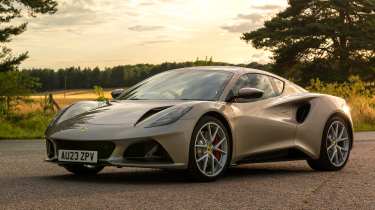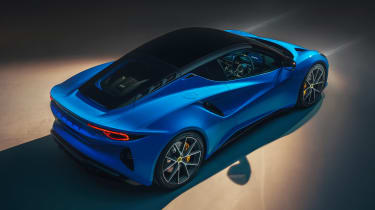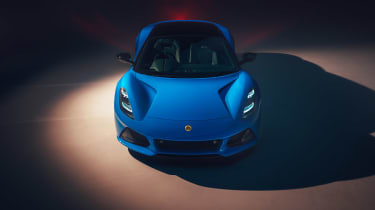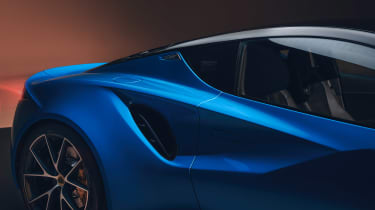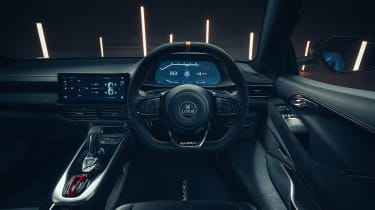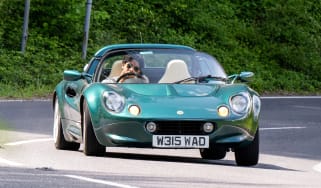AMG powered Lotus Emira priced from £81,495
The Lotus Emira range has doubled with the introduction of the AMG-powered 360bhp 2-litre, turbo-charged four-cylinder model
We were deeply impressed – if not enamoured – by the Lotus Emira when we drove it in flagship V6 form last year, but that first taste left us wondering whether the slightly lighter turbocharged four-cylinder version might just be the sweeter sports car. We're a little closer to finding out, with the entry-level model making its debut at the Goodwood Festival of Speed before reaching customers later in the year.
Priced from £81,495, the 360bhp model is powered by an AMG sourced four-cylinder engine, undercutting the 395bhp Toyota powered V6 model by £4500. As with the V6, the new 2-litre model is initially available in First Edition spec (a base-level trim will become available in 2024) – this brings a host of optional extras and visual tweaks, with identical performance to the standard car. The four-cylinder Emira, which also produces 317lb ft of torque, completes the 0-62mph sprint in 4.4-seconds, and runs on to a 171mph top speed. It's only available with AMG's eight-speed double-clutch gearbox.
Two-piece brake discs and 20-inch forged wheels come as part of the First Edition upgrades, along with nappa leather interior trim, a 560W KEF audio system and 12-way electrically adjustable and heated seats. Front parking sensors, rain sensing wipers and a reversing camera are included as part of the Convenience Pack, with the Driver’s Pack giving buyers the option of either Tour or Sport suspension and Goodyear Eagle F1 Supersport or stickier Michelin Pilot Sport Cup 2 tyres. A new cast aluminium sub-frame for the AMG sourced engine saves 12kg, with the four-cylinder Emira weighing in at 1405kg – 53kg less than its V6 counterpart.
The four-cylinder Emira uses a modified version of Mercedes-AMG’s M139 2-litre turbocharged engine that sends 360bhp to the rear wheels. Though Lotus has borrowed hardware from AMG, its engineers have made numerous changes to improve the engine's mid-mounted integration, with a Lotus-design exhaust system, tweaked mapping and that modified AMG sourced eight-speed dual-clutch transmission.
Gavan Kershaw, Director of Vehicle Attributes at Lotus, said: ‘It’s a bespoke rear-wheel drive variant of the transmission developed by Lotus in collaboration with AMG. On top of that, the gearshift strategy has been defined by the Hethel team as part of the car’s performance attributes. It is unique to the Emira and optimised for the best blend of outstanding driving engagement and performance, fuel consumption and emissions.’
The new Emira is a direct rival for Alpine’s A110 and the Porsche 718 Cayman, sitting between the two mid-engined cars in terms of focus and performance with two very different powertrain options. It will also be the last pure internal combustion engine sports car the company will develop from scratch, before Lotus turns attention towards its intensive electrification programme which has seen it develop the new Eletre SUV.
Emira 3.5-litre V6, supercharged
The Emira launched in 2022 with the familiar supercharged 3.5-litre V6 from Toyota, rated at 395bhp. It’ll be available with both a six-speed manual (complete with an exposed gear linkage as in the current cars) or a six-speed torque-converter automatic with a limited slip differential also fitted.
Despite its humble origins in all forms of mundane Toyota family cars in other markets, it’s a very different proposition now, having proven itself an effective and vocal sidekick in everything from the laid-back Evora GT410 to the hardcore Exige Cup.
Changes to the engine over the Evora and Exige application include work on the induction and exhaust system to improve throttle response and give it a more textured vocal range to eradicate the on-off noise generated by the outgoing models. The V6-engined car rivals more serious sports cars such as Porsche’s Cayman GTS 4.0 and the BMW M2.
This engine isn’t expected to last though, with the proposed EU7 emission regulations due in 2027 signalling the end of V6 for European and UK Lotus customers, although it could continue to be offered in other territories with less stringent emission controls. It’s for this reason why Lotus turned to a second technical partner, Mercedes-AMG, to develop an alternative power source.
| Lotus Emira V6 | Porsche 718 Cayman GTS 4.0 | |
| Engine | 6-cyl, 3456cc, supercharged | 6-cyl, 3995cc |
| Gearbox | 6-speed man/6-speed auto | 6-speed man/7sp PDK |
| Power | 395bhp @ 6800rpm | 394bhp @ 7000rpm |
| Torque | 310lb ft @ 3500rpm | 310lb ft @ 5000rpm |
| Weight | 1458kg | 1405kg |
| Power-to-weight | 289bhp/ton (est) | 285bhp/ton |
| 0-62mph | 4.3sec | 4.5sec |
| Top speed | 180mph | 182mph |
| Price | £85,995 | £73,300 |
Emira 2-litre four-cylinder, turbocharged
Lotus has turned to new technical partner AMG to supply the Emira's second powertrain, with the German marque’s 2-litre turbocharged four-cylinder engine from the A45 hot hatch. As in its applications within AMG, the engine uses a twin-scroll turbocharger and will only be available with an eight-speed dual-clutch transmission.
Using the more powerful M139 from the A45 models with a Lotus-specific calibration, the four cylinder model is 53kg lighter overall compared to the V6. It also comes with a revised stability control system and torque vectoring-by-braking on the rear axle, with unique chassis tuning optimised for the lighter powertrain configuration.
| Lotus Emira | Alpine A110S | Porsche 718 Cayman S | |
| Engine | 4-cyl, 1991cc, turbo | 4-cyl, 1798cc, turbo | 4-cyl, 2497cc, turbo |
| Gearbox | 8-speed DCT | 6-speed DCT | 6-speed man/7sp PDK |
| Power | 360bhp @ 6600rpm | 288bhp @ 6400rpm | 345bhp @ 6500rpm |
| Torque | 317lb ft @ 3000rpm | 236lb ft @ 2000rpm | 310lb ft @ 2100rpm |
| Weight | 1446kg | 1114kg | 1355kg |
| Power-to-weight | 260bhp/ton (est) | 263bhp/ton | 259bhp/ton |
| 0-62mph | 4.4sec | 4.4sec | 4.6sec |
| Top speed | 171mph | 161mph | 177mph |
| Price | £81,495 | £62,490 | £61,800 |
Chassis
All Emira models are underpinned by the same extruded aluminium chassis pioneered by the Elise 25 years. This new bonded aluminium chassis houses both transversely-mounted powertrains, has a wider track than the Evora and double-wishbones and coilover dampers at all four corners with anti-roll bars front and rear. Two very distinct chassis setups will be offered regardless of powertrain – Touring and Sport – the latter available as part of an optional Drivers Package that lowers the ride highest and includes uprated dampers, springs and anti-roll bars. And for the sceptics out there, not a single piece of suspension has been carried over from the Evora.
This package will also be optimised for different tyres, with standard Touring models fitted with Lotus bespoke Goodyear Eagle F1 Supersport rubber and Driver’s Pack cars fitted with sticker Michelin Pilot Sport Cup 2s.
Being larger (in most directions) than both the Cayman and Alpine - it’s not far off some current Porsche 911 Carrera dimensions - and without the featherweight-focus of the latter, the Emira won’t be as lithe as its French counterpart, weighing in at 1405kg at its lightest, a near-300kg rise. This does make it bang-on the weight of a Porsche 718 Cayman GTS 4.0, but weights remain to be confirmed for the four and six-cylinder Lotus models.
There won't, however, be a roadster or targa-top variant, with Lotus prioritising ultimate dynamism over an open-top experience.
Adding weight is not part of the Lotus DNA and great lengths have been taken to keep the gain as low as possible, so while 60kg of new technology has been added to the car it only weighs 11kg more than the Evora 400.
Lotus has kept steadfast in its application of purely hydraulic steering, though, joining McLaren as one of the very few manufacturers that have resisted fitting electric steering in favour of its cleaner feel, despite an admittedly tiny compromise in fuel consumption. To this Lotus has designed and developed its own all-new steering rack to maintain its signature feel and texture in a car that is fitted with 20-inch tyres.
As with any modern performance car there are switchable driver modes, but these are restricted to the throttle and gearbox mapping (the latter only on cars with the double-clutch or automatic gearbox fitted obviously), due to the passive chassis and hydraulic steering. And also Gavin Kershaw’s philosophy that the chassis and the steering’s weight and its rate of response shouldn’t need to be adjusted if you want to go quicker if the engineers have done their job correctly in the first place. Which is refreshing to hear.
Design and interior
The interior ergonomics and exterior design is another artful blending of Lotus elements but reimagined for a new generation. The coke-bottle silhouette isn’t far removed from the Evora, but is interjected with an Evija-inspired side intake that breaks up the bodywork.
In fact, Russell Carr and his design team were inspired by the Evijia hypercar, a project they had already embarked upon when they were given the go ahead to begin work on the Emira in 2018.
Look at the two cars side-by-side and you can clearly see a very close relationship between the two, such as the bonnet where the shutlines into openings are integrated within the surfacing, and the new vertically stacked LED headlights and wheel arch peaks are also straight from the Evija.
The cabin is simple, elegant and a huge step forward in terms of quality, finished to a standard unseen from a car built at Hethel, which is down to the impressive new production facility the Emira is being produced in.
Inside there’s a high double-layer centre console not unlike the Alpine A110, topped with sharp digital interfaces (the electrical architecture is taken from parent company Geeley) and minimal controls. Key functions such as the air-conditioning controls and volume are still physical switches or buttons, so too the engine start button that lives underneath a flip-up cover not unlike a Lamborghini.
> Radford Lotus 62/2 full specs and details

